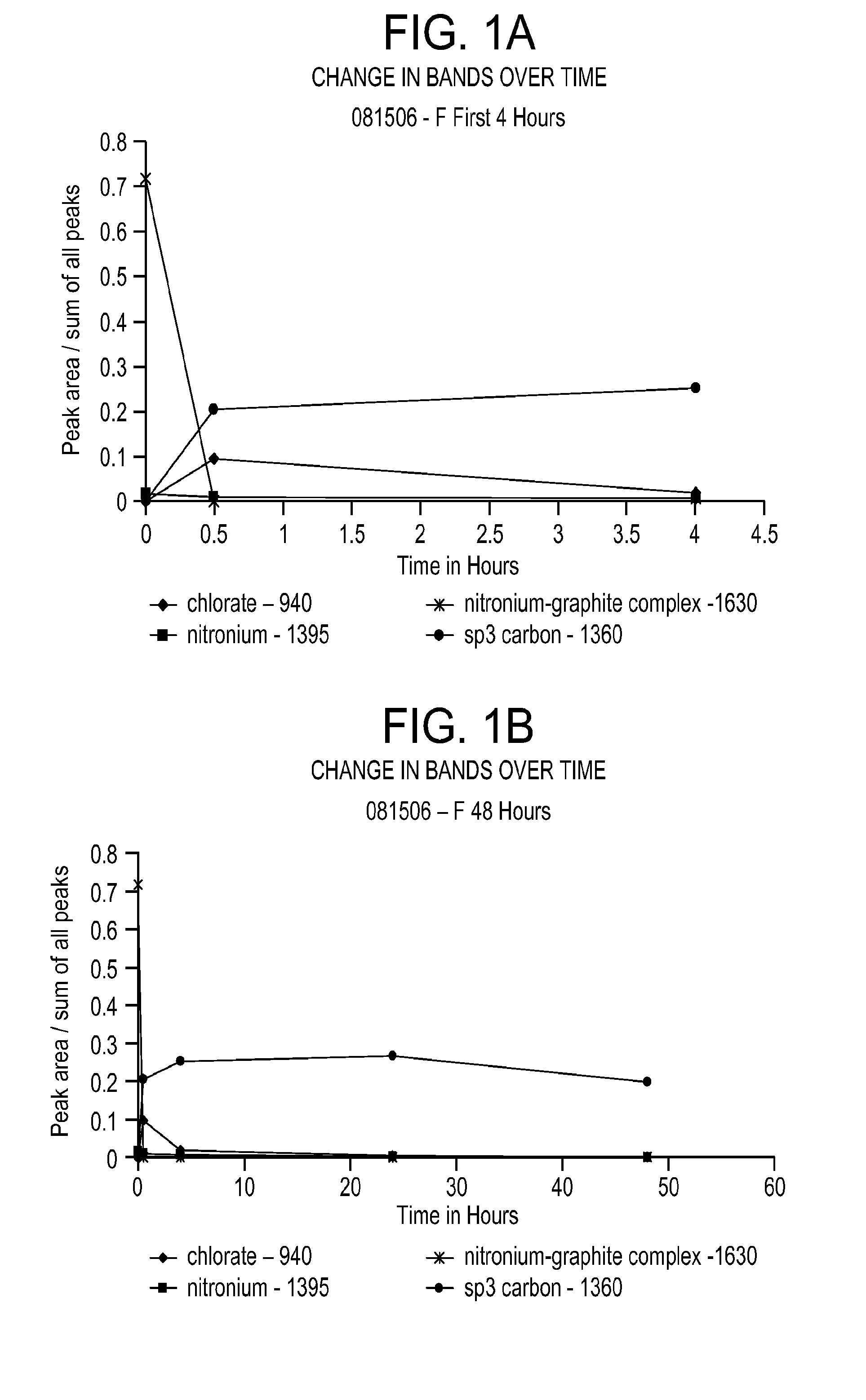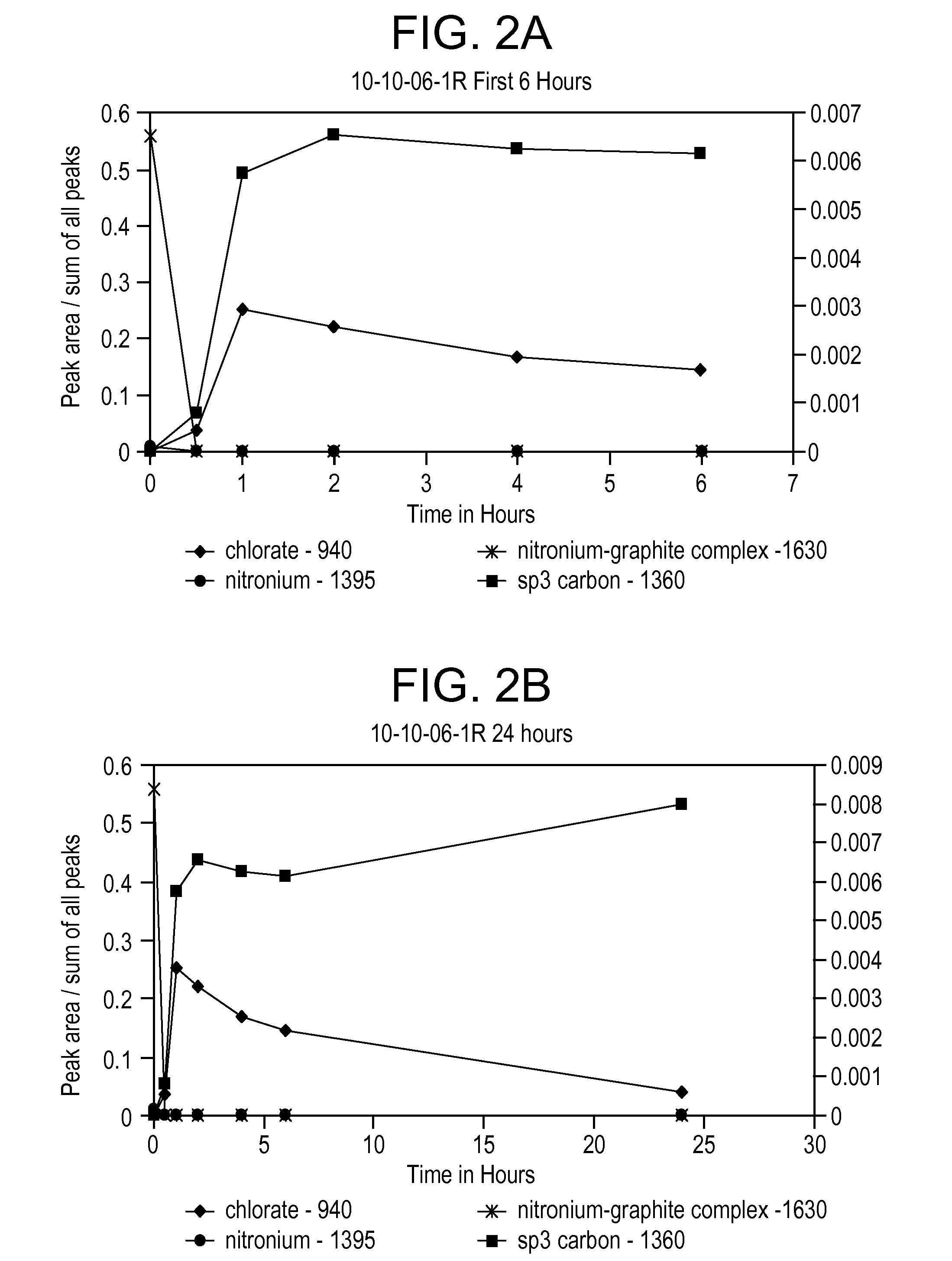Highly efficient process for manufacture of exfoliated graphene
- Summary
- Abstract
- Description
- Claims
- Application Information
AI Technical Summary
Benefits of technology
Problems solved by technology
Method used
Image
Examples
example 1
Oxidation of Fine Graphite at Graphite to Chlorate Ratio of 1 to 2.75
[0068]This example demonstrates the oxidation reaction at a chlorate salt to graphite weight ratio of 2.75 to 1. Fine graphite (−325 mesh) is used. Details of the reaction and product are provided in Table 3.
TABLE 3Experiment descriptionSampleBET SurfaceDetailsReaction TimeNo.area (m2 / g)0.9 g Fine graphiteBaselinerxa0054NM(−325 mesh);(acid +Done in a 50 mL beaker;graphite)30 mL mixed acid;30minutesrxa0057NMBulk addition of 2.475 g4hourrxa005820KClO3;24hourrxa006119Covered with weigh boat48hourrxa006322
[0069]Use of low concentration of KClO3 results in a fairly low surface area product, measured to be 22 m2 / g. Raman spectroscopic analysis of the reaction reveals that upon addition of the KClO3, the nitronium ion concentration immediately decreases and the sp3 carbon band at 1360 cm−1 appears for the first time, indicating the oxidation of the graphite (see FIG. 1A, showing reaction progress over the first 4 hours). ...
example 2
Oxidation of Coarse Graphite at a Graphite to Chlorate Ratio of 1 to 2.75
[0070]This example demonstrates the oxidation reaction at a chlorate salt to graphite weight ratio of 2.75 to 1. Coarse graphite (−10 mesh) is used. Details of the reaction and product are provided in Table 4.
TABLE 4Experiment descriptionSampleBET SurfaceDetailsReaction TimeNo.area (m2 / g)0.9 g Coarse graphiteBaselineRxa0064NMDone in a 100 mL graduated(acid +cylindergraphite)30 mL mixed acid30minutesRxa0066NMBulk addition of 2.475 g4hourRxa006870KClO324hourRxa007063Covered with weigh boat48hourRxa007260
[0071]Use of lower concentration of KClO3 with coarse graphite result in a fairly low surface area product, measured to be 60 m2 / g. Raman analysis reveals that that upon addition of the KClO3, the nitronium ion concentration immediately decreases and the sp3 carbon band at 1360 cm−1 appears for the first time, indicating the oxidation of the graphite (see FIG. 3A). FIG. 3B shows that sp3 carbon continues to increa...
example 3
Oxidation of Coarse Graphite at a Graphite to Chlorate Ratio of 1 to 8.25
[0072]This example demonstrates the oxidation reaction at a chlorate salt to graphite weight ratio of 8.25 to 1. Coarse graphite (−10 mesh) is used. Details of the reaction and product are provided in Table 5.
TABLE 5Experiment DescriptionSampleBET SurfaceDetailsReaction TimeNo.Area (m2 / g)0.9 g Coarse graphiteBaselinerxa0065NMDone in a 100 mL graduated(acid +cylindergraphite)30 mL mixed acid30minutesrxa0067NMBulk addition of 7.425 g KClO34hourrxa0069120Covered with weigh boat24hourrxa007117548hourrxa0073180
[0073]Use of a higher concentration of KClO3 results in a surface area of about 180 m2 / g. This is a reasonably high surface area for coarse graphite. Raman analysis illustrates that upon addition of the KClO3, the nitronium ion concentration immediately decreases and the sp3 carbon band at 1360 cm−1 appears for the first time, indicating the oxidation of the graphite (see FIG. 4A). FIG. 4B shows that sp3 carbo...
PUM
 Login to View More
Login to View More Abstract
Description
Claims
Application Information
 Login to View More
Login to View More - R&D
- Intellectual Property
- Life Sciences
- Materials
- Tech Scout
- Unparalleled Data Quality
- Higher Quality Content
- 60% Fewer Hallucinations
Browse by: Latest US Patents, China's latest patents, Technical Efficacy Thesaurus, Application Domain, Technology Topic, Popular Technical Reports.
© 2025 PatSnap. All rights reserved.Legal|Privacy policy|Modern Slavery Act Transparency Statement|Sitemap|About US| Contact US: help@patsnap.com



